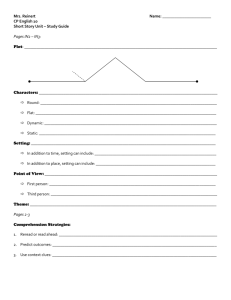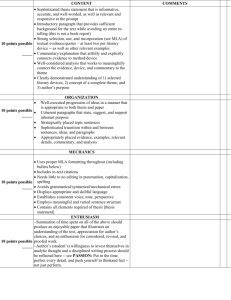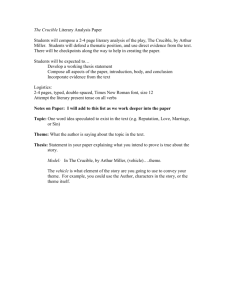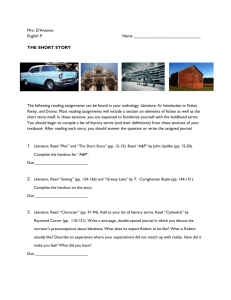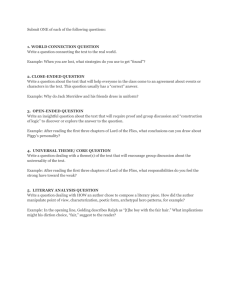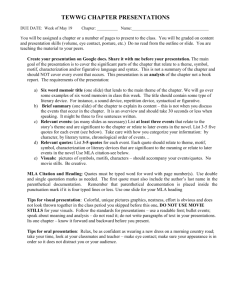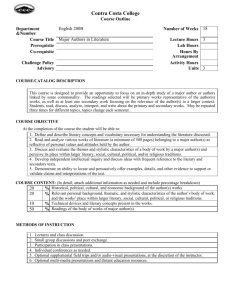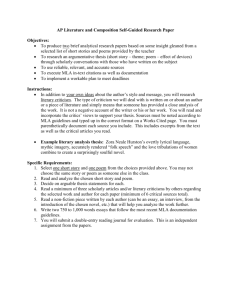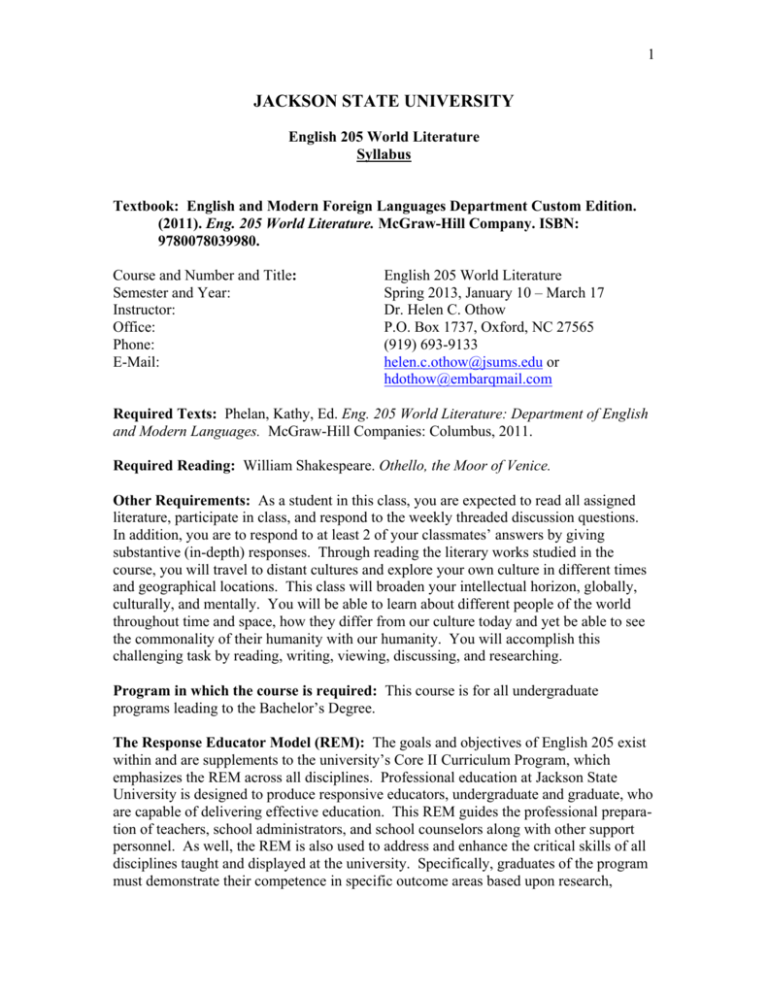
1
JACKSON STATE UNIVERSITY
English 205 World Literature
Syllabus
Textbook: English and Modern Foreign Languages Department Custom Edition.
(2011). Eng. 205 World Literature. McGraw-Hill Company. ISBN:
9780078039980.
Course and Number and Title:
Semester and Year:
Instructor:
Office:
Phone:
E-Mail:
English 205 World Literature
Spring 2013, January 10 – March 17
Dr. Helen C. Othow
P.O. Box 1737, Oxford, NC 27565
(919) 693-9133
helen.c.othow@jsums.edu or
hdothow@embarqmail.com
Required Texts: Phelan, Kathy, Ed. Eng. 205 World Literature: Department of English
and Modern Languages. McGraw-Hill Companies: Columbus, 2011.
Required Reading: William Shakespeare. Othello, the Moor of Venice.
Other Requirements: As a student in this class, you are expected to read all assigned
literature, participate in class, and respond to the weekly threaded discussion questions.
In addition, you are to respond to at least 2 of your classmates’ answers by giving
substantive (in-depth) responses. Through reading the literary works studied in the
course, you will travel to distant cultures and explore your own culture in different times
and geographical locations. This class will broaden your intellectual horizon, globally,
culturally, and mentally. You will be able to learn about different people of the world
throughout time and space, how they differ from our culture today and yet be able to see
the commonality of their humanity with our humanity. You will accomplish this
challenging task by reading, writing, viewing, discussing, and researching.
Program in which the course is required: This course is for all undergraduate
programs leading to the Bachelor’s Degree.
The Response Educator Model (REM): The goals and objectives of English 205 exist
within and are supplements to the university’s Core II Curriculum Program, which
emphasizes the REM across all disciplines. Professional education at Jackson State
University is designed to produce responsive educators, undergraduate and graduate, who
are capable of delivering effective education. This REM guides the professional preparation of teachers, school administrators, and school counselors along with other support
personnel. As well, the REM is also used to address and enhance the critical skills of all
disciplines taught and displayed at the university. Specifically, graduates of the program
must demonstrate their competence in specific outcome areas based upon research,
2
faculty assumptions, and beliefs about the roles of responsive education. The specific
outcome areas and a brief statement of assumption for each follow.
The English Proficiency Exam: All students are expected to take the English
Proficiency exam in their sophomore year.
Course Description: English 205 is a one semester survey of classical literary
masterpieces representative of the Ancient, Medieval, Renaissance, and Modern periods.
The course will assist the student in reading literary works with increased perceptiveness
and understanding of the complex resources available to the imaginative writer for the
representation of human experience and reality. The purpose of the course is to enhance
the student’s appreciation for the enjoyment of literature; furthermore, the course will
provide the student with added oral and written experience in the analysis and interpretation of imaginative works which have significantly contributed to the Western World.
Course Objectives:
1. To expose students to diversity, using different regions and literature to make
comparisons
2. To teach students how to connect different genres of literature from different
cultures through research and collaboration
3. To teach critical thinking and writing skills, using literature and literary concepts
4. To compare different genres of literature through analysis and research
5. To compare two different time periods and show the significance of these
differences through writing and discussion
6. To teach students how to analyze literature using literary terms and concepts
7. To enhance students’ research skills by using primary and secondary sources
8. To integrate technology that enhances learning environments and extends
performance
9. To identify and demonstrate how literary works can act as a bridge to nurture
multicultural relationships by showing the commonality of all mankind
10. To instruct students how to view multimedia links to enhance their knowledge
and perception of literature
11. To identify and demonstrate how literary works act as historical documents and
culture carriers
Instructional Strategies: The following strategies will be implemented in the
class; however, other creative strategies also may be utilized:
1.
2.
3.
4.
5.
6.
7.
Peer editing
The use of power point presentations
The use of weekly discussion threads on topics relevant to the literary selections
The engagement in research using primary and secondary sources
The inclusion of famous quotations while writing about literature
Using the dropbox to submit writing assignments
Using databases and other library resources while conducting research
3
8. Using the Navigation Tree to access assignments for each day and week
9. Using historical and global background study in literary research
10. Using the Richard Wright Center
11. Writing scholarly research papers
12. Studying and using the MLA style of documentation in in-text citations and the
Works Cited page
Late Assignment Policy: Students are responsible for reading all assigned literary
works, lecture notes, and completing all writing assignments. No student will be
allowed to turn in late or missed assignments under any circumstances. Only in
the event of extenuating circumstances will a student be allowed to make-up
work. Excuses have to be approved by the instructor before the assignment is
due – there will be a penalty.
Method of Student Evaluation: Students will be required to write four documented
essays, compile an Annotated Bibliography, develop a Thesis Statement and Outline,
submit a draft and a final paper for each essay. Students also must participate in
weekly threaded discussions. In addition to each student’s response to the discussion
question (the DQ), each student must respond to at least 2 of his or her classmate’s
answers with a substantive (in-depth) response free of mechanical and grammatical
errors. Responses to the DQ must be submitted to the discussion board by
Wednesday of each week by 9:00 p.m. All writing assignments must be submitted to
the Dropbox on Saturday by 9:00 p.m.
Under Course Home before doing assignments for Week One, all students must take
the Online Orientation quiz
10%
15 Analytical Essays, including
50%
the first draft of your research paper,
which should include your thesis
statement and outline, the annotated
bibliography, parenthetical citations,
and a Works Cited page in the MLA
style.
6 Discussion Threads
20%
(including your response and
your response to 2 classmates)
Final Exam (Final Draft of Paper)
20%
Total
100%
All documented and writing assignments must be typed in the most recent format of
the MLA documentation style. Essays must be double-spaced with a Heading at the
top left-hand corner of your paper. The Heading must be single-spaced and include:
Your Name, your Instructor’s Name, the Name of the Course and Section Number,
and the Date. The title of your paper should be centered above the first paragraph.
The print must be in black ink. Use the Times New Roman font, number 12 size.
4
If you have an Everyday Writer, the textbook used in English 218, there is a section in
the book on the MLA style of documentation for in-text citations and the Works Cited
page. This text can be purchased from the bookstore at Jackson State University.
Also every library has a copy of the latest MLA style manual. If you can not access
the above sources, visit http://owl.english.purdue.edu.
Grading Scale:
90 - 100
A
80 – 89
B
70 – 79
C
60 – 69
D
59 and below
F
The Instructor’s Scale for Grading Essays:
First Draft of Essay
Content
Style
Mechanics
Total
25
5
20
50
Final Essay
Content
Style
Mechanics
Total
50
10
40
100
Special Needs Learners:
If you have a disability for which you are or may be requesting accommodations, you
are encouraged to contact both your instructor and the Office of the Americans with
Disabilities Act (ADA) Coordinator and Compliance Officer, P.O. Box 17999,
Jackson, MS 39217, telephone (601) 979-2485 as early as possible in the term.
Diversity Statement:
Jackson State University is committed to creating a community that affirms and
welcomes persons from diverse backgrounds and experiences and supports the
realization of their human potential. We recognize that there are differences among
groups of people and individuals based on ethnicity, race, socioeconomic status,
gender, exceptionalities, language, religion, sexual orientation, and geographical area.
All persons are encouraged to respect the individual differences of others.
Caveat:
5
In the event of extenuating circumstances, the instructor has the right to modify the
schedule and requirements for this course. All students will be notified of the
changes in advance.
Class Participation Policy: As an online student you are expected to keep up with
all assignments and to submit them to the dropbox on the date that they are due. This
is a fast-paced course; therefore, you are encouraged to work ahead if possible in
order to meet the deadlines. Also check the calendar to make sure all assignments are
submitted on time.
Academic Honesty Statement: All papers should be your work. If you are
dishonest and plagiarize, it will result in your failing the course. Do not copy
anyone’s work and use it as your own.
Bibliography/References:
Adams, Hazard, ed. Critical Theory Since Plato. Fort Worth: Harcourt, Brace.
Jovanovich College Publishers, 2004.
Aristotle: Excerpts from “Poetics VI, XIII – XV.” Translated by L.J. Potts from
Aristotle on the Art of Fiction. Cambridge: Cambridge University Press,
1959.
Asante, Molefi Kete and Abu S. Abarry, eds. African Intellectual Heritage: A
Book of Sources. Philadelphia: Temple University Press, 1966.
Barnstone, Willis and Tony Barnstone, eds. Literature of Asia, Africa, and Latin
America. Upper Saddle River: Prentice Hall, 2008.
Bevington, David, ed. William Shakespeare. Notes on “Hamlet” and “Othello”
from The Complete Works of Shakespeare. 4th. edition, 1997.
Charters, Ann and Samuel Charters, eds. Literature and Its Writers. Boston:
Bedford Books, 2004.
Else, Gerald F. Aristotle Poetics. Translated, with an Introduction by Gerald
Else. Ann Arbor, Michigan: The University of Michigan Press,
1967.
Hill, Patricia Liggins, et al. Call and Response: The Riverside Anthology of
the African American Literary Tradition. New York: Houghton Mifflin
Company, 1998.
Kennedy, X.J. and Dana Gioia. Literature: An Introduction to Fiction, Poetry,
Drama, and Writing. New York: Pearson/Longman, 2007.
6
Lines, Patricia M. “Antigone’s Flaw.” From Humanities, Vol. XII, no. 1, National
Humanities Institute, 1999.
Meyer, Michael. Thinking and Writing about Literature. Boston: St. Martin, 2000.
Pickering, James and Jeffery Hooper. A Concise Companion to Literature. New
York: Macmillan, 1981.
Roberts, Edgar and Henry Jacobs. Literature: An Introduction to Reading and
Writing. Englewood Cliffs: Prentice –Hall, 2008.
Schwiebert, John. Reading and Writing from Literature. Boston: Houghton
Mifflin, 2001.
Weekly Assignments and Readings
General Introductions to the Course
Course Home
After taking the Student Online Tutorial, respond to Please Read and Respond on
the Navigation Tree on the left of the Platform. You must respond to these questions
before proceeding to the assignments for Week One. This quiz is a requirement. You
will receive 10 points if you answer the questions correctly.
Always check the Course Calendar to see that you are completing all assignments
and on the date due.
Week 1:
Introduction of Yourself to the Class.
Exploring the Elements of Fiction
Know the definition of the following terms: character, theme, point of view,
symbol, tone, language, style, allegory, protagonist, and antagonist
North American Literature
Reading Assignments: Richard Wright. “The Man Who Was Almost a Man.” pages
249 – 254.
Nathaniel Hawthorne. “Young Goodman Brown.” Pages 226 – 231.
Key concepts: oppression, racism, sharecropping, identity, religious faith,
superstition, image of black men in society (past and present), stream of
consciousness, symbolism, and allegory.
Review: MLA Documentation for Parenthetical Citations and the Works Cited page.
Most libraries have the MLA Style Manuals (the latest edition). Also review the
Elements of Fiction from the Lecture Notes on the Navigation Tree.
7
Writing Assignment: Due Saturday, January 19th.1. Write 3 paragraphs about
Character, Theme, and Setting in “The Man Who Was Almost a Man.” Focus on
defining manhood and the way in which society views black males. Does society
respect black men and allow them to have a fair opportunity? How are they
perceived? Additionally, what various themes does Richard Wright convey to his
readers about the plight of the black male and his role in society?
2. Within the text, find the barriers that prevent Dave from possessing manhood.
Look for quotations within the short fiction to support your opinion. After your
quotation, use a parenthetical citation in the MLA style. Focus on the setting, the
time period, and the language in the story. How do these elements define Dave as
a character?
“Young Goodman Brown”:
Writing Assignment: Due Saturday, January 19th.
1. Write 3 paragraphs about the character, theme, and setting in Hawthorne’s short
fiction. Is the story realistic or a fantasy? Explain.
2. What is the character of Young Goodman Brown and his wife, Faith? How do the
two characters contrast with each other?
3. Is this story an allegory? Explain your answer by quoting lines from the story and
using parenthetical citations in the MLA style.
4. How does the author use setting to convey the story? What is the theme of the
story?
5. Add another paragraph to these writing assignments (paragraph 7). Explain how
“Almost a Man” and “Young Goodman Brown” compare and/or contrast with
each other.
6. At the end of your assignment, have a Works Cited page in the MLA style as
follows:
Phelan, Kathy, ed. Eng. 205 World Literature: Department of English and Modern
Languages. “Almost a Man” by Richard Wright. Columbus: McGrawHill, 2011.
Phelan, Kathy, ed. Eng. 205 World Literature: Department of English and Modern
Languages. “Young Goodman Brown” by Nathaniel Hawthorne.
Columbus: McGraw-Hill, 2011.
7. Submit your writing assignments to the dropbox.
Week 2
Identifying Elements of Drama and Political Discourse
Mediterranean Literature
Key Themes: Understanding the political issues that exist in Greek drama, the role
of women and the role of men in society, defining individualism, civil disobedience,
anarchy, patriotism, the law of the gods vs. the law of the state, and diplomacy.
Reading Assignment:
8
Sophocles. Antigone (c. 441 B.C.), pages 11 – 33.
Know Aristotle’s concept of Tragedy as he explains it in his lecture notes Poetics.
Note how he particularly admired the portrayal of the heroes and heroines in
Sophocles’ plays. Also read the Introduction to Antigone, pages 11 – 12.
Know the meaning of the following Literary Terms: tragedy. arête. hubris, atê,
nemesis, and harmateia (tragic flaw).
Writing Assignment: Due Saturday, January 26th.
1. Write 5 paragraphs in which you explain why Antigone is the protagonist and
heroine in the play. Also explain what role the other characters (a) Ismene, (b)
Haemon, (c) Teresias, (d) Creon, and (e) the Chorus play in driving the plot and
revealing the meaning of the play. Discuss the meaning of the play using some of
the key themes and literary terms mentioned above. Submit your essays to the
dropbox.
Test on the play Antigone. Due by February 2nd.
Week 3:
North American Literature
Key Themes: political discourse, civil disobedience, anarchy, patriotism, and
diplomacy.
Literary Terms: setting, conflict, character, theme, protagonist, antagonist, and
symbolism
Reading Assignment: Martin Luther King, Jr. “Letter from a Birmingham Jail.”
See the link on the eplatform.
Writing Assignment: Due Saturday, February 2nd.
Write 5 paragraphs explaining the following:
1. The setting of “Letter from a Birmingham Jail” and to whom is the letter
addressed? What is the initial situation of the letter?
2. What does Martin Luther King, Jr. consider to be his mission in Birmingham?
3. On what grounds do the clergymen of Birmingham consider King to be an
“outside agitator’?
4. Instead of resorting to negotiating with his opponents, Dr. King preferred
“nonviolent tension.” What does he mean by that term?
5. Finally, compare Dr. King’s situation in jail with Antigone’s being sentenced to
death for burying her brother.
Week 4:
Continental European Literature
9
Key Literary Terms: Verisimilitude, protagonist, antagonist, theme, setting,
psychological realism, and moral.
Reading Assignment: Fyodor Dostoyevsky. “The Heavenly Christmas Tree,” pages
117 – 120.
Writing Assignment: Due Saturday, February 9th.
1. Formulate a thesis statement and outline to assist in organizing your essay.
2. Write 5 paragraphs on “The Heavenly Christmas Tree.”
3. How does Dostoyevsky portray verisimilitude in depicting poverty in the story?
4. What is the major theme in the story?
5. How does the narrator appeal to the senses? What senses does he appeal to?
Quote passages that show his appeal to the senses (smelling, tasting, hearing,
seeing, feeling, and thinking)/
6. Why does the writer have the setting at Christmas time and in Petersburg in
Russia? Research some background information about Petersburg, Russia.
Midterm Test – Due by Saturday, February 16th.
Week 5:
Modern African Literature
Key Literary Terms: hyperbole, litotes, silence, suspense, surprise ending
Key Themes: apartheid, African traditions, African religious beliefs, communalism
versus individualism, and Negritude.
Reading Assignments:
Alan Paton. “A Drink in the Passage,” pages 125 - 129. (South Africa)
Chinua Achebe. “Marriage is a Private Affair,” pages 133-136. (Nigeria, West
Africa)
Bessie Head. “The Lovers,” pages 137 – 145. (South Africa and Botswana)
Leopold Senghor. “Black Woman,” page 130. (Senegal, West Africa)
Writing Assignments: Due Saturday, February 16th.
1. Write 3 paragraphs about “A Drink in the Passage,” discussing the setting during
the era of apartheid in South Africa. Apartheid was similar to discrimination in
the United States. There were 3 groups of people who were kept separate by law,
the whites, the coloreds (mixed race), and the blacks in South Africa. Explain
how the story depicts racial separateness by referring to passages in the story.
How does apartheid affect Edward Simelane, the black South African, and van
Rensburg, the white South African in the story? How does the author use irony in
the story?
2. Write 3 paragraphs about “Marriage is a Private Affair,” answering the following
questions: What features in the story suggest how strong customs are in
traditional African society? Discuss the theme of the story and the character of
Okeke. Is he a flat character or a dynamic character. Also discuss Achebe’s skill
10
in writing a narrative description and his use of suspense. Use quotations from
the story to support your analysis. Then use parenthetical citations in the MLA
style. Put the author’s last name and page number in parenthesis after the
quotation. How does the story convey African customs about marriage?
3. Write 3 paragraphs about Bessie Head’s “The Lovers.” What does Head achieve
by using a third person omniscient narrative perspective? Find the meaning of the
terms folklore, legend, and romance? Which one of these literary genres is the
story?
4. Write 3 paragraphs in which you discuss the theme of Senghor’s “Black Woman.”
Show how the style and figures of speech in the poem convey the ideas of
Negritude. Quote lines and use parenthetical citations to document the source.
5. At the end of your essays on the 4 literary selections from Africa, have a Works
Cited page in which you include each of the selections you have written about.
Week 6:
Asia and the South Pacific
Key Literary Terms: point of view, setting, tone, surprise ending, meaning, theme,
purpose, conflict, epiphany, and foreshadowing.
Reading Assignments:
Yosunari Kawabata. “The Grasshopper and the Bell Cricket,” pages 153-155. Japan
Shen Congwen. “Life,” pages 156 – 160. China
Writing Assignments: Due Saturday, February 23rd.
1. Write 3 paragraphs about “The Grasshopper and the Bell Cricket,” explaining the
theme of the story. What meaning and purpose do you gain from the story? Can
the story be compared with a Japanese painting? Does the story represent a
revelation or epiphany? What is the overall effect of the story which is conveyed
by the tone. Have a thesis statement in which you use 3 of the literary terms to
express how the theme of the story is conveyed.
2. Write 3 paragraphs about “Life.” Discuss the theme of this story. Such stories as
this one have to be read at least twice because the author waits until the end of the
story to reveal something he has not mentioned before. What clues does the
author give to show the meaning of the story and how does the author use foreshadowing to reveal its meaning. This story can be read on at least two levels, the
literal level and the figurative or symbolic level. Why is one of the puppets black
and the other white? What is the relationship between the character’s puppet
show and the death of the character’s son? Use some of the literary terms above
as you analyze the story.
South and Central America
Key Literary Terms: theme, moral, style, magical realism, folklore, closed form of
poetry, open form of poetry, and satire
Reading Assignments:
11
Rosario Castellanos. “Chess,” pages 190 – 191. Mexico
Gabriel Garcia Marquez. “A Very Old Man with Enormous Wings: A Tale for
Children,” pages 192 – 195. Colombia
Writing Assignments: Due Saturday, February 23rd.
1. Write 3 paragraphs about the poem “Chess.” Explain what style the poem is
written in. Is it open form or closed form? Explain how it is that particular form.
Analyze the 3-part structure of the poem. What pattern is used in the structure?
Do the three parts represent the Beginning, Middle, and End? What moral
(lesson) does the poem teach?
2. Write 3 paragraphs about “A Very Old Man with Enormous Wings.” What clues
in the story show that the setting of the story is a country of Roman Catholicism.
Would you describe this story as a satire or a folktale? Explain the theme of the
story and in what ways the theme is shown. Choose 3 of the literary terms above
to describe how they convey the theme. Colombia was one of the first places that
Africans were brought to in the new world. Compare and contrast Bessie Head’s
short story “The Lovers” with the story of The Spider Woman in this story.
Week 7:
Great Britain and Ireland
Key Themes: blindness, Christian duty, revenge, treachery, darkness versus light,
appearance versus reality, good versus evil.
Reading Assignments:
John Milton. “On His Blindness,” page 333. England
William Shakespeare. Othello, the Moor of Venice, pages 264 – 326.
Writing Assignments: Due Saturday, March 2nd.
1. Write 5 paragraphs explaining the theme of “On His Blindness.” Have a thesis
statement which expresses the theme and which shows at least 3 ways in which
the theme is shown. Use 3 of the literary terms that we have discussed to show
how the theme is expressed through them.
2. Write the first draft of a Research Paper on Othello, the Moor of Venice. Choose
one (1) of the following themes to write about the play: Appearance versus
Reality; Race; Pride; Jealousy; Magic; Order versus Chaos; Self-Knowledge;
Honesty; Misrepresentation; Good versus Evil; Sight and Blindness. Have a
Thesis Statement which expresses the theme. Then show 3 ways in which the
theme is expressed by choosing 3 of the following literary terms:
Characters
Plot_ Initial Situation, Defining Event, Crisis, Climax,Culminating Event, & Final
Event
Symbolism
Metaphors
Similes
12
Character’s Speeches (Soliloquys)
Conflict
Resolution of Conflict
Perepeteia (Change of Fortune, from a person of high estate to a person of low
Estate)
Tragic Flaw (harmateia, excessive pride, excessive naiveté)
Imagery
3. Find at least 2 scholarly journal articles that have been written about the play
Othello by using databases; such as, Master File Premier, EBSCOhost, Pro Quest,
CQResearcher, and the MLA Bibliography.
4. Make an Annotated Bibliography of the two articles you have found. First write
the bibliographical information about the journal article or a chapter from the
book. Put the bibliographical information in the MLA style, as the source would
be written on the Works Cited page. Under the citation, write 2 paragraphs. In
the first paragraph state what the writer’s thesis statement is. In the second
paragraph give the supporting ideas that the author gives in support of his or her
thesis statement. Do the same for the next article that you find.
The Purpose for Having an Annotated Bibliography
The purpose for finding sources other than your own ideas is to strengthen
your ability to write about literature and to know what other scholars in the field say
about the literary selection. Another reason to conduct research on the literary work
is to substantiate your ideas and to learn how to incorporate other scholars’ ideas in
your research paper, using the MLA style of documentation. Your first draft of the
research paper should include your thesis statement and outline, the annotated
bibliography, parenthetical citations in the body of your paper in the MLA style, and
a Works Cited page including the textbook and the two journal articles you have
found.
Never use websites as sources in your research paper nor Wikipedia
as as source.
Your first draft of your research paper will be due by Friday of Week 7.
Week 8:
The final draft of your research paper will be due by Friday of Week 8, March
15, 2013. The final draft of your research paper will be your final exam.


